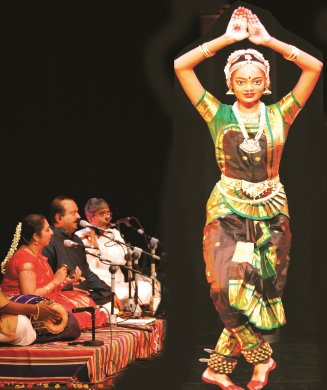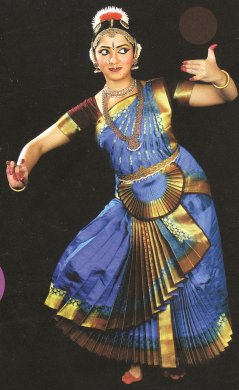
|   |

|   |
Young dancers revel - Dr. M. Surya Prasad e-mail: drmsuryaprasad@gmail.com June 19, 2015 Great infusions of talent and energy have been coming to the world of classical dance form of Bharatanatya from increasingly unexpected places. And thankfully the dancers so featured are exuding as much genuine warmth as they do it with boundless artistic confidence. The two dance recitals held recently, none overly long, provided a perfect amount of entertainment and also a fine augury for the prosperity of the ancient classical dance form. Young Manasvini Balakrishnan is trained by Guru M.S. Srilakshmi, a seasoned exponent of Bharatanatya of Singapore. Tall, slim and blessed with large eyes, Manasvini presented an enterprising Bharatanatya at SRT theatre, Bangalore, that was clearly out to show the range of what she is capable of. The dance and its quality immediately established an intimate rapport with the audience. Her execution of the movements demonstrated a high degree of professionalism, particularly in the abhinaya segments. Manasvini danced with confidence and lot of enthusiasm. A Pushpanjali by percussionist Prasannakumar in Hamsananda raga suitably set the invocative tone for an auspicious beginning of the recital. She saluted the Mother Earth, Guru, accompanists and audience. She delivered a festive piece dedicated to the elephant-headed deity Ganesha (Varavallabharamana, Hamsadhwani). The khanda alarippu and Todi jathiswara had intricate footwork alternating between fast and slow steps. Her neck and limb movements, brisk footwork, postures et al further enhanced the celebratory mood of the dance. The rhythm and melody became livelier as the show continued. The dancer took an interesting and enticing ragamalika varnam for a detailed treatment. It was a vibrant reflection of her command over the eclectic elements of this genre of Indian classical dance. The varnam in Kannada Neelamegha Shyamasundarana kare tare Sakhi by mridangist Gurumurthy was all about Lord Krishna and his sports. Ragas like Shuddha Saveri, Kaanada, Mohana and others chained together not only highlighted the moods of the lyrics but was also made beautiful by vocalist Srivatsa’s melodious singing. The fast paced recitation and execution of jathis enthralled the rasikas. The manner in which Manasvini negotiated the repartees was a delight to watch. The characterization of Krishna spoke of her acting abilities. At the same time her hold over nritta and nrithya also came to the fore vividly. As usual, the performance following the intermission increasingly focused on the facial expressions of the dancer. The pieces required the dancer to hold numerous positions with the left foot lifted and Manasvini accomplished the balancing acts with graceful ease. Shiva stuti (Aadenamma) in Pharaz was notable for well etched freezes of Lord Shiva. The depiction of Navarasas was praiseworthy. With spirited and inspiring nattuvanga by Guru Srilakshmi, the musical ensemble comprising of D.S. Srivatsa (vocal), Lazar Thurakkal Sebastine (violin), Tiruchy L. Sharavanan (flute) and Gurumurthy (mridanga) imparted a lively support. The theme of a young woman imploring her lover to come back to her and talk to her was impressively enacted by the dancer on the basis of a Poorvi Kalyani javali Nee maatalemaayanura. Naaganrithya set to Punnagavarali raga was an added attraction. The dance recital concluded with a tillana in Sindhubhairavi raga  Manasvini Balakrishnan  Sindhura Kanti Talented dancer K.V. Manasa made a vibrant comeback to the Bharatanatya field as an efficient guru at ADA Rangamandira, Bangalore. She presented her disciple Sindhura Kanti in a neat program. It was noteworthy for its technical standard, the dancer’s subtle command over expressions and the vivacious quality of the performance. Both guru and disciple’s involvement and sincerity were indeed the hallmarks of the evening’s performance. Accompanied appropriately by Guru Manasa (nattuvanga), Ramesh Chadaga (vocal), Dr. Natarajamurthy (violin), Skandakumar (flute), Lingaraju (mridanga) and Prasannakumar (morsing), Sindhura opened with a traditional pushpanjali (Hamsadhwani) and salutation to dancing Ganapathi (Natya Ganapathige). There was a fine clarity with sensitively phrased nritta. The Nalinakanthi jathiswara formed a fine synthesis with jathis and adavus. Complicated rhythmic phrases were translated into demanding varieties of adavus. The Khamach varna (Bhuvana Sundarana kare taare) had a captivating combination of music and melody. It was an absolute delight with the dancer rising to the more dynamic passages with a natural energy. Sindhura held the delicate ebb and flow of the rhythm beautifully in the nritta portions. The Krishna theme was unfolded with ease and poise. If the pace fueled her body with dancing energy then Sindhura has, one can only assume, done her job. She then went on to display her refinement in abhinaya. She chose to delineate Krishna and Gopikas in a profound interpretation. Goddess Parvathi as the sister of Lord Vishnu was evoked next through Nagagandhari krithi Sarasijanabha sodari preceded by a shloka. The chittaswaras were neatly translated into laudable nritta. The composition of Purandaradasa’s Seraga bido Ranga (Yaman) with Krishna and Radha as main characters was then in the forefront of the recital as she performed it joyously displaying the pranks of Lord Krishna. The finale number of the Bharatanatya repertoire was the Amrithavarshini tillana which revealed the dancer's command over rhythmic patterns and sculpturesque poses. Dr. M. Surya Prasad is an acclaimed and accredited international music and dance scholar, critic and a prolific columnist. |